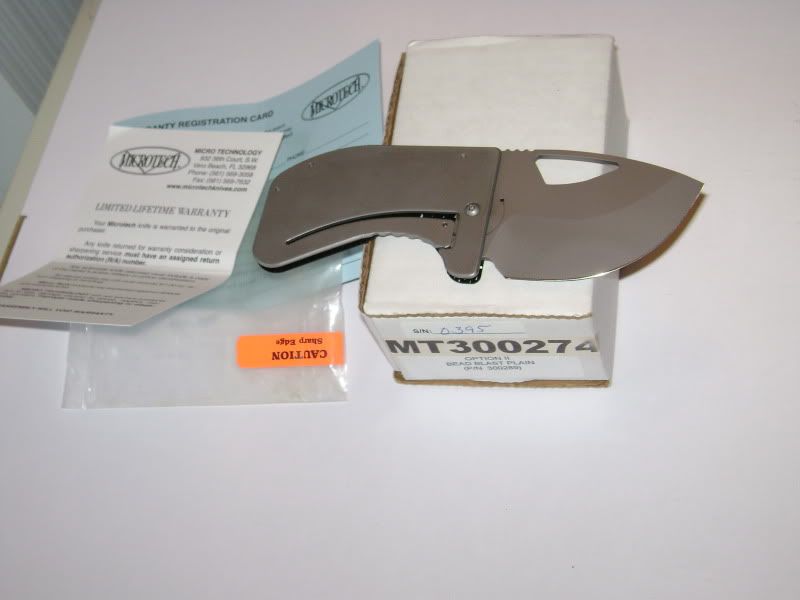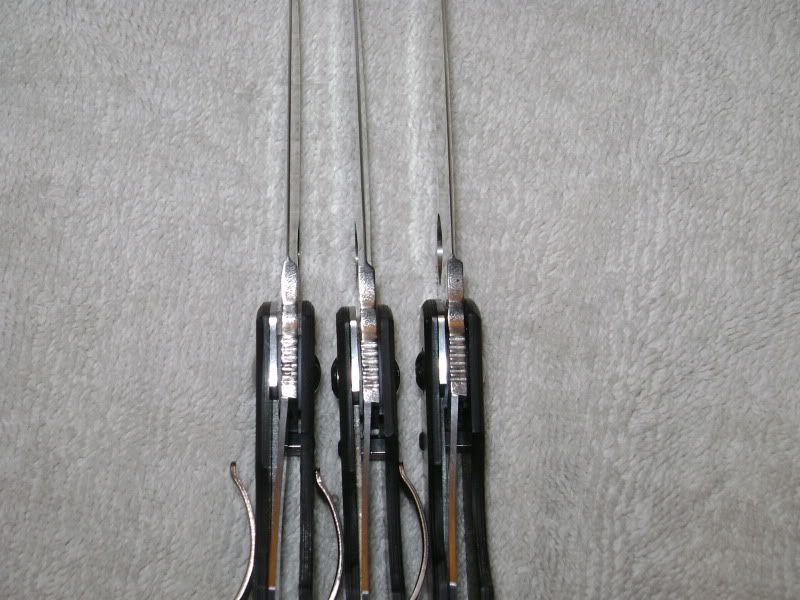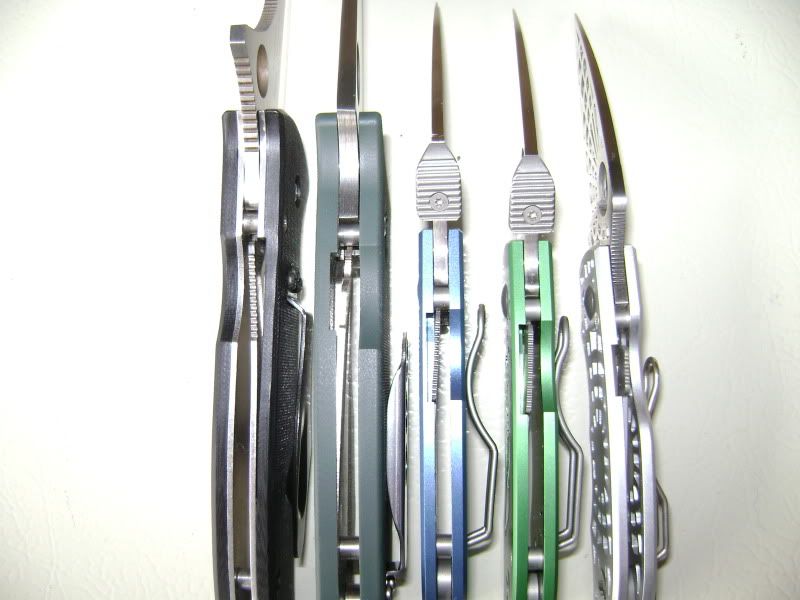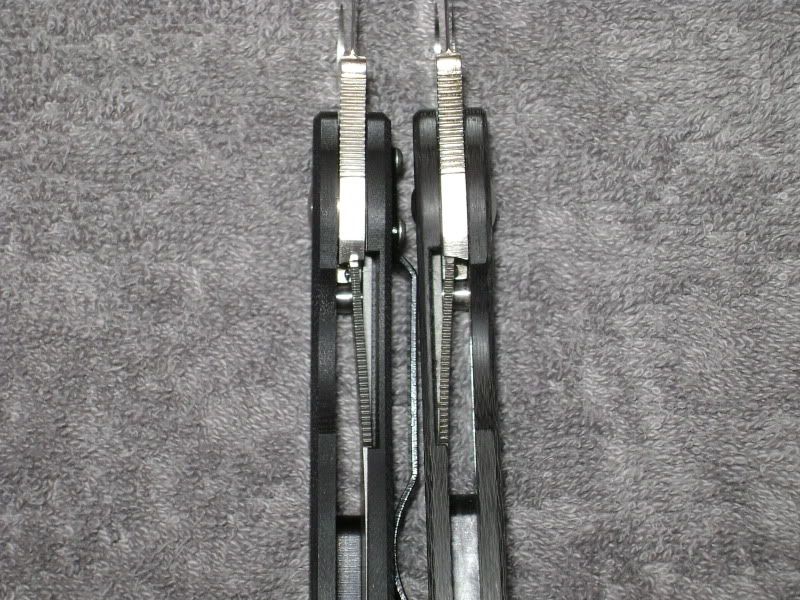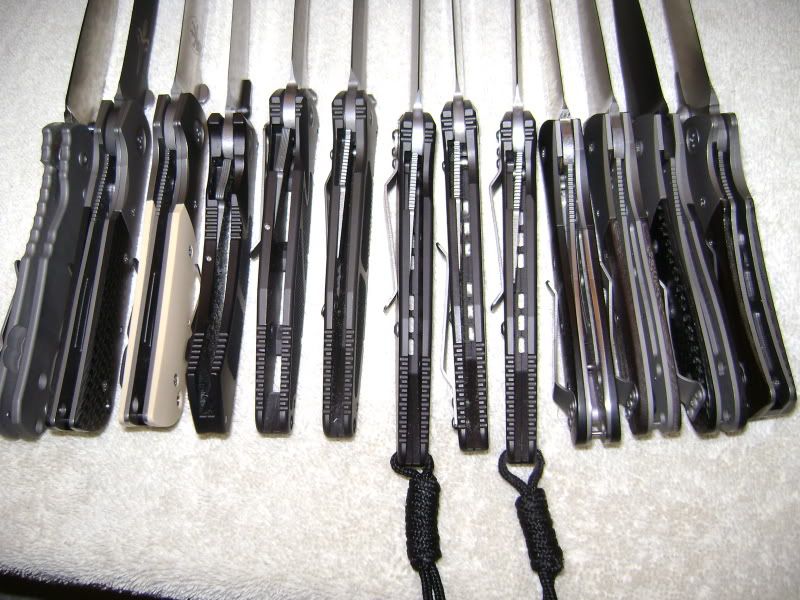What differentiates Walker locks from Reeve locks
- The Deacon
- Member
- Posts: 25717
- Joined: Fri Sep 24, 2004 10:33 am
- Location: Upstate SC, USA
- Contact:
 What differentiates Walker locks from Reeve locks
What differentiates Walker locks from Reeve locks
Thought this deserved its own thread.
It may seems like an easy question, but the line has been getting blurry for me. Both work on the same general principle, a lock bar which presses against the lower portion of the blade tang when the knife is open, and contains a ball bearing to help retain the blade in the closed position. But what actually defines each lock. Is it that the Walker has a full, or almost full, scale on the lock side? Is it that the Reeve's lockbar is thick enough to require a relief cut? Some combination of those? Something else entirely?
It may seems like an easy question, but the line has been getting blurry for me. Both work on the same general principle, a lock bar which presses against the lower portion of the blade tang when the knife is open, and contains a ball bearing to help retain the blade in the closed position. But what actually defines each lock. Is it that the Walker has a full, or almost full, scale on the lock side? Is it that the Reeve's lockbar is thick enough to require a relief cut? Some combination of those? Something else entirely?
Paul
My Personal Website ---- Beginners Guide to Spyderco Collecting ---- Spydiewiki
Deplorable :p
WTC # 1458 - 1504 - 1508 - Never Forget, Never Forgive!
My Personal Website ---- Beginners Guide to Spyderco Collecting ---- Spydiewiki
Deplorable :p
WTC # 1458 - 1504 - 1508 - Never Forget, Never Forgive!
- chuck_roxas45
- Member
- Posts: 8776
- Joined: Wed Mar 03, 2010 5:43 pm
- Location: Small City, Philippines
I'd have thought that if the locking arm is made from the material and is integral to the handle material, that's a RIL. OTOH, if the actual locking arm is made and is part of the material that adds rigidity to the actual handle material, then that makes it a Walker.
http://uproxx.files.wordpress.com/2014/ ... ot-gif.gif" target="_blank
- The Deacon
- Member
- Posts: 25717
- Joined: Fri Sep 24, 2004 10:33 am
- Location: Upstate SC, USA
- Contact:
Sounds logical. But by that standard, a Sage I could be considered is a RIL, since for all intents and purposes, the CF scales are decorative rather than structrual. I can think of several other models that would apply to as well.chuck_roxas45 wrote:I'd have thought that if the locking arm is made from the material and is integral to the handle material, that's a RIL. OTOH, if the actual locking arm is made and is part of the material that adds rigidity to the actual handle material, then that makes it a Walker.
Bradley is probably the most extreme case. Spyderco lists it as a Walker lock, but the proud liners expose just slightly less metal than is exposed on the lock side of my Mnandi and I'd bet the CF scales are no more necessary than the Mnandi's snakewood ones.
Paul
My Personal Website ---- Beginners Guide to Spyderco Collecting ---- Spydiewiki
Deplorable :p
WTC # 1458 - 1504 - 1508 - Never Forget, Never Forgive!
My Personal Website ---- Beginners Guide to Spyderco Collecting ---- Spydiewiki
Deplorable :p
WTC # 1458 - 1504 - 1508 - Never Forget, Never Forgive!
- chuck_roxas45
- Member
- Posts: 8776
- Joined: Wed Mar 03, 2010 5:43 pm
- Location: Small City, Philippines
There will probably be particular models that will be hard to put in a niche. :DThe Deacon wrote:Sounds logical. But by that standard, a Sage I could be considered is a RIL, since for all intents and purposes, the CF scales are decorative rather than structrual. I can think of several other models that would apply to as well.
Bradley is probably the most extreme case. Spyderco lists it as a Walker lock, but the proud liners expose just slightly less metal than is exposed on the lock side of my Mnandi and I'd bet the CF scales are no more necessary than the Mnandi's snakewood ones.
http://uproxx.files.wordpress.com/2014/ ... ot-gif.gif" target="_blank
I think it has to do with how the force is applied to the lock bar.
In a Walker lock, the lock bar is bent. When pressure is put on the back of the blade, the lock bar will bend a tiny bit to resist this. The bent metal will absorb a little bit of shock.
In a Reeve lock, the lock bar is almost perfectly straight. When pressure is put on the back of the blade, the lock bar will push straight down the handle.
Maybe there is something to the handle being softer than the blade in that there is nowhere for impact to go and you don't want the RIL to bend.
In a Walker lock, the lock bar is bent. When pressure is put on the back of the blade, the lock bar will bend a tiny bit to resist this. The bent metal will absorb a little bit of shock.
In a Reeve lock, the lock bar is almost perfectly straight. When pressure is put on the back of the blade, the lock bar will push straight down the handle.
Maybe there is something to the handle being softer than the blade in that there is nowhere for impact to go and you don't want the RIL to bend.
-Brian
A distinguished lurker.
Waiting on a Squeak and Pingo with a Split Spring!
A distinguished lurker.
Waiting on a Squeak and Pingo with a Split Spring!
- CanisMajor
- Member
- Posts: 928
- Joined: Tue Jun 02, 2009 9:53 am
- Location: USA
That's a good question Deacon, I've never really thought about it. Hopefully someone knows the actual answer.
Canis
Canis
Dare. Risk. Dream.
"Your body may be gone, I'm gonna carry you in.
In my head, in my heart, in my soul.
And maybe we'll get lucky and we'll both live again.
Well I don't know. I don't know. I don't know. Don't think so."
- Modest Mouse "Ocean Breathes Salty"
"Your body may be gone, I'm gonna carry you in.
In my head, in my heart, in my soul.
And maybe we'll get lucky and we'll both live again.
Well I don't know. I don't know. I don't know. Don't think so."
- Modest Mouse "Ocean Breathes Salty"
- The Deacon
- Member
- Posts: 25717
- Joined: Fri Sep 24, 2004 10:33 am
- Location: Upstate SC, USA
- Contact:
Very true, and I'm sure the only real "answer" to my question is that the clear differences that once existed don't always exist anymore. Rather than setting out to "build a WLL" or "build a RIL" the goal is to build a knife that works well and, once it's built, they have to call it something.MCM wrote:Spyderco gives credit to the design by using the name of the originator.
Most Co's just call 'em Liner locks or Frame locks.
Paul
My Personal Website ---- Beginners Guide to Spyderco Collecting ---- Spydiewiki
Deplorable :p
WTC # 1458 - 1504 - 1508 - Never Forget, Never Forgive!
My Personal Website ---- Beginners Guide to Spyderco Collecting ---- Spydiewiki
Deplorable :p
WTC # 1458 - 1504 - 1508 - Never Forget, Never Forgive!
- chuck_roxas45
- Member
- Posts: 8776
- Joined: Wed Mar 03, 2010 5:43 pm
- Location: Small City, Philippines
Makes sense. :)The Deacon wrote:Very true, and I'm sure the only real "answer" to my question is that the clear differences that once existed don't always exist anymore. Rather than setting out to "build a WLL" or "build a RIL" the goal is to build a knife that works well and, once it's built, they have to call it something.
http://uproxx.files.wordpress.com/2014/ ... ot-gif.gif" target="_blank
For what it's worth, here are some words from Chris Reeve on the design, from the website:
"...My first impressions of the liner lock style locking mechanism were very favorable but when I examined it more closely, I decided that I didn't much like the flimsiness of the thin liner. After some thought, I redesigned the concept and have created the Sebenza Integral Lock© which I believe to be the most rugged folding knife on the market.
There are major differences, IMO, on the two locks.
The additon of a scale on the Walker Linerlock contains the lock and helps to prevent the "bent" linerlock from blowing out the sides when we break the lock.
The Reeve Ingtegral lock has the added advantage of your hand directly on the lock which increases sensitivity to the lock itlself as well as increasing lock reliablility.
Just to mention a couple of things to add to the discussion. I expect a good definition when the thread is complete. :p
sal
The additon of a scale on the Walker Linerlock contains the lock and helps to prevent the "bent" linerlock from blowing out the sides when we break the lock.
The Reeve Ingtegral lock has the added advantage of your hand directly on the lock which increases sensitivity to the lock itlself as well as increasing lock reliablility.
Just to mention a couple of things to add to the discussion. I expect a good definition when the thread is complete. :p
sal
-
cmassicotte
- Member
- Posts: 1052
- Joined: Fri Sep 24, 2004 10:33 am
- Location: Buena Park, CA USA
I agree, great question. I too, have wondered about the difference. While I had given it some thought, I had never thought it through to any kind of conclusion until I saw this thread. Could it simply be a matter of original intention when designing the knife?
What I mean is, could it be that when Walker developed his liner lock, the design concept included both liner and scales. And when Chris Reeve developed the RIL, there was never a thought to having a scale? This would mean that if you added a scale to an RIL you would still have an RIL, and if you were to remove the scales from a Walker (liner) lock (not practical, I know), you would still have a Walker lock.
I do have a question to throw into the mix - and I hope I am not hijacking the thread - but....
Is a frame lock just a different name for an RIL?
Chuck
What I mean is, could it be that when Walker developed his liner lock, the design concept included both liner and scales. And when Chris Reeve developed the RIL, there was never a thought to having a scale? This would mean that if you added a scale to an RIL you would still have an RIL, and if you were to remove the scales from a Walker (liner) lock (not practical, I know), you would still have a Walker lock.
I do have a question to throw into the mix - and I hope I am not hijacking the thread - but....
Is a frame lock just a different name for an RIL?
Chuck
There is no right way to do a wrong thing
-
Frapiscide
- Member
- Posts: 242
- Joined: Sun Apr 18, 2010 11:57 am
In my opinion, there are three factors:
1: Thickness
2: How it's bent
3: Scales or no scales
1: If you look, most to all liner lock are fairly thin (~1mm), frame locks tend to be thicker.
2: How it's bent. A liner lock, the company just bends the metal itself until the desired angle and springyness is achieved. On a frame lock, they mill out a section near the bottom of the cut separating the bar form the handle, for the best leverage possible. They then bend it until the desired springyness is acquired.
3: Liner locks have scales on the outside, to increase rigidity and to prevent hyperextension. Frame locks, however, don't have scales, as they don't need the extra rigidity, and might have a Hinderer Stop lock to prevent hyperextension.
Even after these factors, though, they are very similar and are essentially the same in the end result. I might be off on some of the things mentioned.
1: Thickness
2: How it's bent
3: Scales or no scales
1: If you look, most to all liner lock are fairly thin (~1mm), frame locks tend to be thicker.
2: How it's bent. A liner lock, the company just bends the metal itself until the desired angle and springyness is achieved. On a frame lock, they mill out a section near the bottom of the cut separating the bar form the handle, for the best leverage possible. They then bend it until the desired springyness is acquired.
3: Liner locks have scales on the outside, to increase rigidity and to prevent hyperextension. Frame locks, however, don't have scales, as they don't need the extra rigidity, and might have a Hinderer Stop lock to prevent hyperextension.
Even after these factors, though, they are very similar and are essentially the same in the end result. I might be off on some of the things mentioned.
Okay I'm just gonna start storming here, bear with me :D
I will start analyzing the different locks and what sets them apart from one another. And ultimately, what defines a Walker linerlock and a Reeve Integral Lock.
Locks are designs and IMO length, width, thickness and all other possible measurements are not a part of the design itself. I know knives where a linerlock bar is as thick as another knife's framelock bar. There are plenty of lockbacks/midlocks with varying sizes. The functioning parts are different sized but they are all still the same lock.
There is also the cutout/bending factor, if we make a linerlocking knife with a liner so thick it has to be cutout, would it make it a framelock? Would the scales that cover the liners and lock completely be just "overlays" now? IMO it's only a feature that was needed to build the original thick RIL. My Spin has a cutout even though the scales are thin enough that it wouldn't exactly need it, but it still has it. If it didn't have it, would you call it a linerlock just because of that? If you were to call it a linerlock, that would mean that the scales are by definition "liners". This categorization however doesn't fit the definition of "liner/lining"...
So the presence/absence cutout alone can't really be a deciding factor either.
If the lockbar is exposed even to some degree, if you grip it hard enough you can actually squeeze the lock even tighter. On the other hand with linerlocks squeezing the handle hard will have no effect on the locking bars engagement and lock strenght. With SOME linerlocks if you squeeze hard enough you might actually disengage the lock. So in the end the deciding factor seems to be how much the scales/overlays are covering the lockbar.
Conclusion:
RIL: The lockbar is completely exposed or it is only slightly covered by an overlay and the overlay still allows the hand to apply pressure on the lockbar making it harder for the lock to disengage.
Walker linerlock: The lockbar is completely covered by a scale on the lockbar side of the handle. Preventing the hand from applying pressure to the lockbar in the way described above.
Just my 0.02. :p
I will start analyzing the different locks and what sets them apart from one another. And ultimately, what defines a Walker linerlock and a Reeve Integral Lock.
Locks are designs and IMO length, width, thickness and all other possible measurements are not a part of the design itself. I know knives where a linerlock bar is as thick as another knife's framelock bar. There are plenty of lockbacks/midlocks with varying sizes. The functioning parts are different sized but they are all still the same lock.
There is also the cutout/bending factor, if we make a linerlocking knife with a liner so thick it has to be cutout, would it make it a framelock? Would the scales that cover the liners and lock completely be just "overlays" now? IMO it's only a feature that was needed to build the original thick RIL. My Spin has a cutout even though the scales are thin enough that it wouldn't exactly need it, but it still has it. If it didn't have it, would you call it a linerlock just because of that? If you were to call it a linerlock, that would mean that the scales are by definition "liners". This categorization however doesn't fit the definition of "liner/lining"...
...as the scales aren't actually covering the inside of anything.Wiktionary wrote: lining:
A covering for the inside surface of something
So the presence/absence cutout alone can't really be a deciding factor either.
But this feature can be achieved with the addition of the Rick Hinderer lockstop alone, so would the addition of a lockstop make it a linerlock? Again a feature that can be found in both locks.sal wrote:The additon of a scale on the Walker Linerlock helps to prevent the "bent" linerlock from blowing out the sides when we break the lock.
This however is IMO the deciding factor that really sets them apart.sal wrote:The Reeve Ingtegral lock has the added advantage of your hand directly on the lock which increases sensitivity to the lock itself as well as increasing lock reliablility.
If the lockbar is exposed even to some degree, if you grip it hard enough you can actually squeeze the lock even tighter. On the other hand with linerlocks squeezing the handle hard will have no effect on the locking bars engagement and lock strenght. With SOME linerlocks if you squeeze hard enough you might actually disengage the lock. So in the end the deciding factor seems to be how much the scales/overlays are covering the lockbar.
Conclusion:
RIL: The lockbar is completely exposed or it is only slightly covered by an overlay and the overlay still allows the hand to apply pressure on the lockbar making it harder for the lock to disengage.
Walker linerlock: The lockbar is completely covered by a scale on the lockbar side of the handle. Preventing the hand from applying pressure to the lockbar in the way described above.
Just my 0.02. :p
:spyder: Come chat with us on IRC at #SharpThings! :spyder:
:spyder: Check out the SharpThings.net website too! :spyder:
:spyder: Check out the SharpThings.net website too! :spyder:
Among other things, it seems to me, a major factor is whether your hand presses the lock closed in use. In a Walker lock, the lock is fully enclosed in the scale, so there is no contact. In a RIL, the hand squeezes the lock while in use. This is why the PPT is a hybrid, because there's a scale, but with enough cut out so the hand can put pressure on the lock.
But the line is blurry when this is really closely analyzed.
But the line is blurry when this is really closely analyzed.
